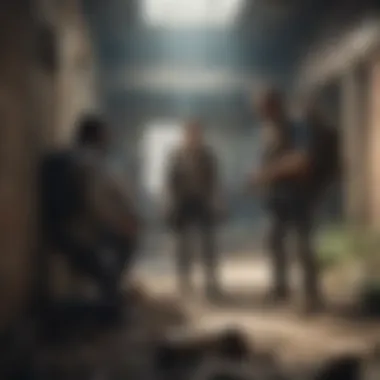Unveiling the Resilience of The Walking Dead Survivors: An In-Depth Analysis


Tips and Strategies
- When embarking on the journey of analyzing The Walking Dead survivors, it is crucial to delve deep into the intricacies of their resilience and survival strategies in a post-apocalyptic realm swarming with the undead. By gaining profound insights into their adaptability, interpersonal dynamics, and the formidable challenges they confront, a comprehensive understanding of their strategies unfurls.
- For novice enthusiasts entering this apocalyptic world, beginner's tips catered to new players serve as a fundamental initiation. These tips encompass essential survival techniques, strategic planning, and resource management to navigate the perilous landscape effectively.
- Advanced strategies tailored for experienced gamers are a necessity for overcoming the heightened stakes and complexities of survival within The Walking Dead universe. These strategies delve into intricate details of combat proficiency, alliance-building, and long-term survival tactics in an unforgiving environment.
- Unveiling hidden secrets and Easter eggs embedded within the intricate layers of gameplay enriches the gaming experience, offering players a thrilling sense of discovery and curiosity. By providing insights into these concealed gems, players can enhance their gameplay and unravel hidden mysteries within the game's expansive world.
- Keeping abreast of updates and patches is crucial to staying ahead in the game. An overview of these modifications provides players with vital information on new features, bug fixes, and enhancements that can elevate the gaming experience and ensure a seamless and engaging adventure.
Introduction
Survivors in 'The Walking Dead' universe navigate a treacherous post-apocalyptic world teeming with zombies and fraught with dangers. This article embarks on a profound exploration of the survivors' experiences, shedding light on their resilience, strategies, and challenges amidst the chaos. By delving into survival tactics and unraveling complex interpersonal dynamics, readers will gain a deep understanding of the fortitude and adaptability exhibited by these characters.
Background of the Apocalypse
In dissecting the cataclysmic events that shaped the new world in 'The Walking Dead,' a crucial aspect to examine is the Origins of the Outbreak. This pivotal occurrence not only set the stage for societal collapse but also implanted seeds of paranoia and uncertainty among the remaining populace. Exploring the origins allows us to grasp the gravity of the survivors' predicament and underscores the fragility of humanity in the face of impending doom.
The aftermath of the initial outbreak brought forth a maelstrom of chaos encapsulated by the term 'Initial Response and Chaos.' This chaotic period tested human resilience as civilization crumbled, revealing the raw truth of how societal structures disintegrate in the wake of a global disaster. Understanding this chaotic phase provides vital insights into the survivors' subsequent actions and decisions, painting a vivid picture of their struggle for survival.
Emergence of Survivors
Amidst the ashes of a fallen world, the Evolution of Survivors showcases humanity's capacity to adapt and endure in the most desolate of landscapes. The Formation of Groups emerges as a survival imperative, as individuals band together to pool resources and protect each other from both the undead and human threats. By delving into the dynamics of group formation, we unveil the nuanced relationships that blossom under duress, emphasizing the poignant alliances forged in the crucible of adversity.
The quest for sanctuary drives survivors to embark on a harrowing journey known as the Search for Safe Havens. This quest for security represents a fundamental desire for stability in a world marred by uncertainty. Analyzing this pursuit illuminates the inherent human longing for safety and normalcy, shedding light on the sacrifices made and risks taken in the pursuit of a safe haven.
Key Themes in Survival
In the unforgiving landscape of 'The Walking Dead,' Survival is underlined by a myriad of profound themes. Resource Scarcity stands as a stark reminder of the harsh reality faced by survivors, where the fight for limited supplies can unravel even the strongest of bonds. Exploring this thematic thread unveils the true cost of survival in a world stripped bare by catastrophe.
Trust and Betrayal form the cornerstone of interpersonal relationships in a post-apocalyptic society, where alliances are forged and shattered with equal frequency. Delving into the intricacies of trust and betrayal unveils the complex tapestry of human emotions at play, underscoring the fragile nature of trust in a world plagued by deceit and desperation.
Survival Strategies
Survival strategies play a pivotal role in the intricate world of The Walking Dead survivors. In this article, we delve into the essence of survival strategies, focusing on their critical importance in navigating the post-apocalyptic landscape. From strategic decision-making to resource allocation, survival strategies form the backbone of survival in a world overrun by zombies and chaos.
Combat Techniques
Weaponry and Defense
Weaponry and Defense are integral components of the survivors' arsenal, crucial for their defense and survival. The utilization of various weapons, ranging from firearms to melee weapons, demonstrates the survivors' commitment to protecting themselves from both zombies and human threats. The key characteristic of Weaponry and Defense lies in their effectiveness in neutralizing enemies, ensuring the safety of the survivors in this hostile environment. While weaponry provides offensive capabilities, defense mechanisms such as barricades and protective gear offer a shield against potential dangers. The unique feature of Weaponry and Defense is their dual functionality, providing both security and a means of confrontation. However, the reliance on weaponry also poses challenges, such as resource scarcity and maintenance requirements which must be addressed to sustain effectiveness.


Hand-to-Hand Combat
Hand-to-Hand Combat showcases the survivors' proficiency in close-quarters engagements, offering a more intimate yet equally critical aspect of defense. The key characteristic of Hand-to-Hand Combat is its versatility, allowing survivors to navigate unpredictable combat scenarios with agility and precision. In a world where ammunition may be scarce, the ability to engage in hand-to-hand combat proves invaluable. The unique feature of Hand-to-Hand Combat lies in its emphasis on physical skill and close combat techniques, enabling survivors to defend themselves even in the absence of conventional weapons. However, engaging in hand-to-hand combat requires significant training and physical exertion, presenting challenges in maintaining peak combat readiness.
Food and Shelter
Foraging and Hunting
Foraging and Hunting serve as essential means of sustenance for The Walking Dead survivors, ensuring their survival in a resource-scarce environment. The survivors' adeptness in identifying edible plants, hunting game, and fishing reflects their resilience in securing nourishment. The key characteristic of Foraging and Hunting is their reliance on the natural environment for sustenance, highlighting the survivors' adaptability in utilizing available resources. While foraging provides immediate sustenance, hunting offers a more substantial source of protein, vital for maintaining energy levels in the face of constant threats. The unique feature of Foraging and Hunting is their integration of traditional survival skills with modern techniques, bridging the gap between past and present methods of food procurement.
Fortification of Safe Zones
Fortification of Safe Zones embodies the survivors' commitment to creating secure locations amidst a perilous world. The construction of barricades, fortifying structures, and establishing defensive perimeters are central to safeguarding survivors against zombie incursions and human adversaries. The key characteristic of Fortification of Safe Zones is its proactive approach to defense, preemptively securing areas to minimize vulnerability. Through fortification, survivors not only create safe havens but also assert their presence in the apocalyptic landscape. The unique feature of Fortification of Safe Zones lies in its communal nature, requiring coordinated efforts to fortify locations effectively. However, the maintenance and fortification of safe zones demand ongoing resources and labor, posing challenges in sustaining security amidst constant threats.
Medical Care and Wellness
First Aid Practices
First Aid Practices epitomize the survivors' commitment to preserving life and health in a world fraught with dangers. From basic wound care to more complex medical interventions, first aid practices serve as a cornerstone of maintaining wellness in challenging circumstances. The key characteristic of First Aid Practices is their immediate response to injuries and illnesses, equipping survivors with essential skills to address medical emergencies promptly. By prioritizing first aid training, survivors ensure their ability to mitigate health risks and promote recovery within their communities. The unique feature of First Aid Practices lies in their universal applicability, transcending age, gender, and background to provide essential healthcare in austere environments. However, the efficacy of first aid practices is contingent upon access to medical supplies and ongoing training, necessitating continual preparation to address emerging health threats.
Psychological Resilience
Psychological resilience represents a fundamental aspect of survival for The Walking Dead survivors, highlighting their ability to navigate trauma and adversity with fortitude. The survivors' mental fortitude, coping mechanisms, and emotional strength are essential pillars in combating post-apocalyptic stressors. The key characteristic of Psychological Resilience is its capacity to endure hardship and persevere in the face of overwhelming challenges, facilitating survivors' mental well-being and adaptability. By cultivating psychological resilience, survivors fortify their minds against despair and hopelessness, crucial for maintaining morale and unity within their groups. The unique feature of Psychological Resilience lies in its role as a protective shield against the psychological toll of survival, empowering individuals to confront fear and uncertainty with resilience. However, sustaining psychological resilience requires ongoing self-care, support systems, and coping strategies to bolster mental health and emotional stability amidst constant turmoil.
Interpersonal Dynamics ()
Leadership and Decision-Making ()
Role of Leaders
In the realm of leadership within the survivors' groups, the role of leaders emerges as a pivotal element. Leaders guide and make critical decisions that impact the entire group's well-being. The key characteristic of effective leaders lies in their ability to inspire hope and maintain order amidst chaos. Their decisiveness and strategic thinking are invaluable assets in navigating the unpredictable landscape of a zombie-infested world. However, the burden of leadership also comes with its own set of challenges, such as balancing pragmatism with empathy and managing dissenting opinions.
Conflict Resolution
Conflict resolution stands as another essential aspect of interpersonal dynamics among the survivors. Resolving conflicts peacefully not only ensures internal harmony but also contributes to the group's overall resilience. The key characteristic of effective conflict resolution lies in fostering open communication and understanding differing perspectives. By addressing conflicts promptly and judiciously, leaders can prevent escalating tensions and maintain a sense of unity within the group. Nonetheless, the intricate nature of conflicts in a high-stress environment necessitates a delicate balance between diplomacy and firmness to achieve sustainable resolutions.


Community Building ()
Building Alliances
Building alliances is a fundamental component of community building among the survivors. Forming strategic partnerships with other groups fosters mutual support and resource sharing, increasing collective chances of survival. The key characteristic of successful alliance-building lies in establishing trust and common goals to navigate threats effectively. While alliances enhance security and collaboration, they also require careful negotiation and maintenance to prevent misunderstandings or betrayals.
Managing Disputes
Effectively managing disputes within the survivor community is paramount to sustaining cohesion and cooperation. The ability to address conflicts impartially and reach fair resolutions is essential for long-term group stability. The key characteristic of dispute management centers on promoting dialogue and finding compromises that uphold justice while preserving relationships. However, navigating sensitive issues and differing opinions demands a high level of emotional intelligence and conflict-resolution skills to prevent rifts from weakening the group's unity.
Survivors' Mental Health ()
Coping Mechanisms
Exploring coping mechanisms reveals crucial insights into how survivors maintain psychological well-being amidst adversity. Coping strategies such as mindfulness practices, artistic expression, or group therapy offer avenues for emotional release and resilience. The key characteristic of effective coping mechanisms lies in their ability to provide emotional relief and promote a sense of control in turbulent times. However, the sustainability of coping strategies relies on individual preferences and adaptability to ever-changing circumstances.
Post-Traumatic Stress
Addressing post-traumatic stress underscores the mental health challenges faced by survivors in a zombie-infested world. Understanding the impacts of trauma and addressing them through therapy or support networks is vital for long-term recovery. The key characteristic of managing post-traumatic stress revolves around creating safe spaces for survivors to process their experiences and heal. While tackling these internal struggles is a daunting task, acknowledging and seeking assistance for post-traumatic stress can pave the way for emotional healing and personal growth.
Challenges and Threats
In the apocalyptic world of The Walking Dead Survivors, understanding the challenges and threats is paramount to survival. From relentless zombie encounters to dangerous human antagonists and unforgiving environmental hazards, the survivors must navigate a treacherous landscape fraught with peril. These challenges not only test their physical abilities but also probe their mental resilience and strategic acumen, making every decision a matter of life or death. By delving into the intricacies of these threats, we unravel the complexities of survival in a world where danger lurks around every corner.
Zombie Encounters
Strategies for Evading Zombies
When it comes to strategies for evading zombies, stealth and resourcefulness reign supreme. The survivors must master the art of silent movement and camouflage to evade detection by the undead hordes roaming the wasteland. By blending into the environment and utilizing distractions effectively, they increase their chances of survival exponentially. However, the inherent risks of close encounters and potential exposure to other threats make this a high-stakes maneuver requiring precision and quick thinking at every turn.
Dealing with Hordes
Dealing with zombie hordes necessitates a delicate balance of firepower and finesse. The survivors must strategize their approach carefully, weighing the benefits of confrontation against the risks of drawing unwanted attention. By understanding the behavioral patterns of hordes and using environmental obstacles to their advantage, they can effectively diminish the threat posed by overwhelming numbers. Nonetheless, the psychological toll of facing such relentless adversaries and the ever-present danger of being overrun underscore the critical nature of preparation and coordination in dealing with hordes.
Human Antagonists


Surviving Bandit Attacks
Surviving bandit attacks demands a blend of tactical prowess and negotiation skills. The survivors must navigate a world where human adversaries pose a different type of threat, one driven by conflicting interests and volatile alliances. By honing their defensive capabilities and enhancing their situational awareness, they can mitigate the risks of ambushes and hostile encounters. Adaptability and diplomacy play crucial roles in resolving conflicts peacefully, ensuring that every interaction with potential foes is a strategic opportunity rather than a perilous confrontation.
Navigating Betrayals
Navigating betrayals requires a keen understanding of human nature and the intricacies of trust. In a post-apocalyptic society rife with deception and self-preservation, the survivors must tread carefully to avoid falling victim to double-crosses and hidden agendas. By fostering genuine relationships built on mutual respect and shared objectives, they can foster alliances that withstand the test of betrayal. However, the constant threat of being betrayed and the emotional toll of severed bonds underscore the fragile nature of trust in a world where survival is the ultimate currency.
Environmental Hazards
Weather Extremes
Weather extremes pose a formidable challenge to the survivors, placing their physical endurance and equipment to the test. From scorching heat waves to bone-chilling blizzards, they must adapt to the ever-changing climate with limited resources at their disposal. By crafting shelter and conserving energy, they can weather the storm and emerge resilient. However, the unpredictability of nature and the inherent dangers of exposure underscore the critical importance of preparedness and vigilance in facing weather extremes.
Resource Depletion
Resource depletion presents a constant struggle for the survivors, forcing them to make tough decisions about allocation and sustainability. As supplies dwindle and demands increase, they must prioritize essential needs while seeking innovative solutions to scarcity. By foraging efficiently and repurposing materials, they can prolong their survival against the backdrop of dwindling resources. Nevertheless, the psychological strain of scarcity and the ethical dilemmas of resource management underscore the ethical complexities of survival in a world where every choice carries weight.
Section 5: Innovative Solutions
In the realm of surviving a post-apocalyptic world overrun by zombies, innovative solutions play a pivotal role in enhancing the chances of staying alive. The concept of innovative solutions encapsulates a wide array of strategies and tools developed by the resourceful survivors in their constant battle for survival. From makeshift weapons to creative communication devices, these solutions showcase the adaptability and ingenuity required to navigate such a hostile environment successfully. By delving into the realm of innovative solutions, this section sheds light on the resourcefulness and tactical acumen employed by the survivors to outsmart both the undead and human adversaries.
Survival Technology
Improvised Tools
Within the scope of survival technology, improvised tools emerge as indispensable assets for the survivors as they scavenge for resources and fortify their encampments. Improvised tools encompass a diverse range of makeshift equipment crafted from whatever materials are at hand, serving dual purposes of defense and utility. The key characteristic of improvised tools lies in their versatility, as they can be repurposed for various functions, from simple repairs to fending off threats. Their haphazard nature often proves advantageous in surprising adversaries, offering a strategic edge in unpredictable encounters. Despite their ad-hoc construction, improvised tools exhibit a rugged effectiveness, making them a popular choice among survivors seeking practical solutions in this chaotic landscape.
Communication Devices
Communication devices stand out as essential equipment for survivors striving to maintain contact and coordinate within their groups. In a world where traditional communication channels are disrupted, these devices fill the void, enabling strategic planning and swift responses to emerging threats. The key characteristic of communication devices lies in their ability to transmit crucial information over varying distances, fostering connectivity and efficient decision-making among dispersed survivor factions. Their reliability and portability make them a preferred choice for integration into the survivors' network, ensuring seamless coordination and timely interventions. However, the reliance on communication devices also exposes vulnerabilities, as signal interceptions by hostile groups pose a constant risk, demanding vigilance and encryption protocols to safeguard sensitive communications.
Self-Sustaining Practices
Surviving in a post-apocalyptic world necessitates embracing self-sustaining practices that minimize dependency on dwindling external resources. Among these practices, solar energy utilization emerges as a game-changer, providing renewable power sources for lighting, heating, and electronic devices. The key characteristic of solar energy utilization rests in its environmental sustainability and independence from conventional power grids, offering a reliable energy alternative in resource-scarce environments. Despite its advantages, the efficiency of solar energy is contingent on weather conditions and maintenance, requiring survivors to balance consumption with conservation to prolong its benefits.
Agricultural initiatives complement solar energy utilization by fostering food security and self-sufficiency among survivor communities. By cultivating crops and raising livestock in controlled environments, survivors mitigate the risks of food scarcity and malnutrition, ensuring a steady supply of nourishment within their settlements. The key characteristic of agricultural initiatives lies in their capacity to yield harvests in challenging conditions, bolstering the resilience of survivors against famine and external threats. However, agricultural practices demand meticulous planning and labor-intensive efforts, underscoring the need for sustainable agricultural practices tailored to the unique challenges of a post-apocalyptic landscape.
Information Gathering
In the quest for survival, information gathering stands as a crucial aspect of strategizing and decision-making in a volatile world teeming with threats. Among the fundamental elements of information gathering are scouting and reconnaissance, essential activities for assessing threats, locating resources, and mapping out territories. The key characteristic of scouting and reconnaissance lies in their role as early warning systems, providing valuable intelligence on potential dangers and opportunities in the survivors' surroundings. Leveraging stealth and observation skills, scouts gather critical data to inform tactical maneuvers and resource allocation, shaping the outcomes of encounters and alliances.
Radio communication stands as a cornerstone of information dissemination and coordination among survivor enclaves, enabling real-time exchanges of vital information and strategies. The key characteristic of radio communication lies in its wide-reaching communication capabilities, bridging gaps across vast distances and enabling swift responses to emergent crises. Despite its reliability, radio communication is vulnerable to signal interference and eavesdropping from hostile factions, necessitating encryption and frequency modulation to secure sensitive transmissions. By harnessing the power of radio waves, survivors fortify their interconnectedness and resilience, forging bonds through shared knowledge and coordinated actions in the relentless fight for survival.



